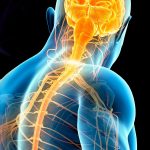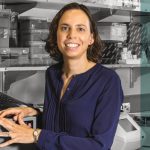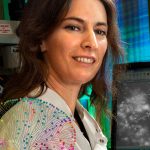FedEx, UPS, DHL—when it comes to sending packages, choices abound. But the most important delivery service you may not have heard of? mRNA. That’s how your DNA sends blueprints to the protein-assembly factories of your cells. Inder Verma and first author Suvasini Ramaswamy, along with industry collaborators, reported the successful treatment of hemophilia B in mice using mRNA to deliver instructions for the clotting protein that is defective in the debilitating bleeding disorder. The therapy, which was described the week of February 13, 2017, in Proceedings of the National Academy of Sciences, is a proof of concept that mRNA therapy could be applied to a range of genetic diseases.
Read News ReleaseDiscoveries
Finding our way around DNA
Most of us would be lost without Google maps or similar route-guidance technologies. And when those mapping tools include additional data about traffic or weather, we can navigate even more effectively. Salk team develops tool that maps functional areas of the genome to better understand disease.
Similarly, Joseph Ecker, first author Yupeng He and collaborators have developed a computational algorithm that integrates two different data types to make locating key regions within the genome more precise and accurate than other tools. The method, detailed during the week of February 13, 2017, in Proceedings of the National Academy of Sciences, could help researchers conduct vastly more targeted searches for disease-causing genetic variants in the human genome, such as ones that promote cancer or cause metabolic disorders.
Read News ReleaseNew method predicts who will respond to lithium therapy
For roughly one-third of people diagnosed with bipolar disorder, lithium is a miracle drug, effectively treating both their mania and depression. But once someone is diagnosed, it can take up to a year to learn whether that person will be among the 30 percent who respond to lithium. Salk Professor Rusty Gage, co–first authors Shani Stern and Renata Santos and colleagues report a way to predict, from neuronal firing patterns and with 92 percent accuracy, whether an individual with bipolar disorder will be a lithium responder. The work, which appeared online in Molecular Psychiatry on February 28, 2017, validates the lab’s 2015 discovery of a cellular basis for the disorder and could benefit not only those who will respond to lithium but also the vast majority who will not, sparing them an ineffective treatment.
Salk scientists expand ability of stem cells to regrow any tissue type
When scientists talk about laboratory stem cells being totipotent or pluripotent, they mean that the cells have the potential, like an embryo, to develop into any type of tissue in the body. What totipotent stem cells can do that pluripotent ones can’t do, however, is develop into tissues that support the embryo, like the placenta. Salk Professor Juan Carlos Izpisua Belmonte, along with first author Jun Wu and researchers from China’s Peking University, discovered a chemical cocktail that enables cultured mouse and human stem cells to generate both embryonic and extra-embryonic tissues. Their technique, described in the journal Cell on April 6, 2017, could yield new insights into mammalian development that lead to better disease modeling, drug discovery and even tissue regeneration.
Read News ReleaseHard choices? Ask your brain’s dopamine
Say you’re reaching for the fruit cup at a buffet, but at the last second you switch gears and grab a cupcake instead. Instead of moving left, your hand went right. Such split-second changes play a major role in diseases that involve problems with selecting an action, like Parkinson’s, OCD and drug addiction. In the March 9, 2017, online publication of the journal Neuron, Salk Professor Xin Jin, co–first authors Christopher Howard and Hao Li and colleagues report that the concentration of a brain chemical called dopamine governs decisions about actions so precisely that measuring the level in mice right before a decision allows researchers to accurately predict the outcome. The work may open new avenues for treating disorders both in cases where a person cannot select a movement to initiate as well as those in which someone cannot stop repetitive actions.
Read News ReleaseIdentical twins; not-so-identical stem cells
In a study published in Cell Stem Cell in April 2017, senior author Juan Carlos Izpisua Belmonte and collaborators have shed light on a longstanding question about what leads to variation in stem cells by comparing induced pluripotent stem cells (iPSCs) derived from identical twins. Even iPSCs made from the cells of twins, they found, have important differences, suggesting that not all variation between iPSC lines is rooted in genetics, since the twins have identical genes. The findings help scientists better understand the processes involved in reprogramming cells and the differences between iPSCs and ESCs (embryonic stem cells). The work could also lead to improvements in the way iPSCs are being used for research and therapeutics.
Read News Release“Exercise-in-a-pill” boosts athletic endurance by 70 percent
Every week, there seems to be another story about the health benefits of running. That’s great—but what if you can’t run? For the elderly, obese or otherwise mobility-limited, the rewards of aerobic exercise have long been out of reach. Co–senior authors Ronald Evans and Michael Downes, together with first author Weiwei Fan and colleagues, have built on earlier work by the lab that identified a gene pathway (PPARD) triggered by running. In the current study, which appeared in Cell Metabolism on May 2, 2017, the team reported fully activating that pathway in sedentary mice with a chemical compound, mimicking the beneficial effects of exercise. They also found that PPARD encourages fat-burning but suppresses sugar-burning in muscles during exercise, likely to preserve sugar for use by the brain. The work reveals why runners who “hit the wall” experience both physical and mental exhaustion upon using up their ready supply of glucose.
Read News ReleaseNovel tool confers targeted, stable editing of epigenome in human stem cells
The lab of Juan Carlos Izpisua Belmonte has developed a novel technology to correct disease-causing aberrations in the chemical tags on DNA that affect how genes are expressed. These types of chemical modifications, collectively referred to as the epigenome, are increasingly being considered as important as the genome itself in development and disease. In the May 4, 2017, issue of Science the team described how they used the tool to model mutations in tags associated with colon cancer and to restore the proper tags in stem cells derived from people with Angelman syndrome.
Helping plants pump iron
Just like people, plants need iron to grow and stay healthy. But some plants are better at getting this essential nutrient from the soil than others. Associate Professor Wolfgang Busch, first author Santosh Satbhai and collaborators have found that variants of a single gene called FRO2 can largely determine a plant’s ability to thrive in environments where iron is scarce. The work, which appeared in Nature Communications on May 24, 2017, could lead to improved crop yields for farmers and richer dietary sources of iron for animals and humans.
Read News ReleaseA better dye job for roots—in plants
Just the right chemical is needed to measure exactly how plant roots grow. Salk’s Wolfgang Busch and collaborators have discovered a fluorescent dye that, paired with other imaging techniques, reveals root growth to be influenced by a major plant hormone more than previously thought. The work, appearing in the Proceedings of the National Academy of Sciences the week of May 29, 2017, could be useful for many types of plant studies, as well as more fully understanding the hormone auxin, which is instrumental for growth and many other critical plant processes. Insights into auxin could, for example, inform the production of faster-growing crops or help mitigate such effects of climate change as drought or early flowering.
Read News ReleaseBrain’s immune cells linked to Alzheimer’s, Parkinson’s, schizophrenia
Scientists have, for the first time, characterized the molecular markers that make the brain’s front lines of immune defense—cells called microglia—unique. In the process, they discovered further evidence that microglia may play roles in a variety of neurodegenerative and psychiatric illnesses, including Alzheimer’s, Parkinson’s and Huntington’s diseases as well as schizophrenia, autism and depression. Professor Rusty Gage and a collaborator from UC San Diego reported in Science on May 25, 2017, that genes previously linked to neurological diseases are turned on at higher levels in microglia compared to other brain cells. While the link between microglia and a number of disorders has been explored in the past, the new study offers a molecular basis for this connection.
Read News ReleaseA star is born: lesser-known brain cell takes center stage
Neurons have long enjoyed the spotlight in neuroscience—and for good reason: they are incredibly important cellular actors. But, increasingly, star-shaped support cells called astrocytes are being seen as more than bit players in the brain’s rich pageant. The lab of Rusty Gage reported a new method of deriving astrocytes from stem cells, opening up broad avenues for research into diseases with inflammatory features. The protocol, which is described in the June 6, 2017, issue of Stem Cell Reports, offers a faster and more effective way to obtain astrocytes for brain research that could yield breakthroughs for treatments of such diverse conditions as stroke, Alzheimer’s or depression.
Read News ReleaseThe Internet and your brain are more alike than you think
Although we spend a lot of our time online nowadays, few of us know about the mathematical algorithms that manage how our content is delivered. But deciding how to route information fairly and efficiently through a distributed system with no central authority was a priority for the Internet’s founders, says Salk Assistant Professor Saket Navlakha. He and his coauthor from Yale University show that an algorithm used for the Internet called additive-increase multiplicative-decrease (AIMD) is also at work in the human brain, an insight that improves our understanding of engineered and neural networks and potentially even learning disabilities.
Read News ReleaseHow cells divide tasks and conquer work
Despite advances in neuroscience, the brain is still very much a black box—no one even knows how many different types of neurons exist. Salk Associate Professor Tatyana Sharpee has used a mathematical framework to better understand how new cell types spontaneously arise and how the various types divide work among themselves. The theory could help reveal how cell types achieve greater efficiency and reliability or how disease results when the division of labor is not as effective.
Read News ReleaseHow the brain recognizes what the eye sees
If you think self-driving cars can’t get here soon enough, you’re not alone. But programming computers to recognize objects is very technically challenging, especially since scientists don’t fully understand how our own brains do it. How precisely this recognition happens is still a mystery, in part because neurons that encode objects respond in complicated ways. Associate Professor Tatyana Sharpee and Research Associate Ryan Rowekamp have developed a statistical method that takes these complex responses and describes them in interpretable ways, which could be used to help decode vision for computer-simulated vision. The duo analyzed how neurons in a critical part of the brain, called V2, respond to natural scenes, providing a better understanding of vision processing and how the brain works in general.
Featured Stories
 Untangling the mysteries of the spinal cordConverging research and innovative technologies are tackling some of the deadliest motor diseases.
Untangling the mysteries of the spinal cordConverging research and innovative technologies are tackling some of the deadliest motor diseases. An interview with Diana HargreavesInside Salk talked with Hargreaves about why she prefers smaller intellectual environments, what excites her about the science she does at the Institute, and how she thinks about being a woman in science.
An interview with Diana HargreavesInside Salk talked with Hargreaves about why she prefers smaller intellectual environments, what excites her about the science she does at the Institute, and how she thinks about being a woman in science. Delving into the best of both worlds with Shani SternAs the only electrophysiologist in the lab, Stern uses her engineering expertise to delve into the biological mysteries that most intrigue her, particularly bipolar disorder.
Delving into the best of both worlds with Shani SternAs the only electrophysiologist in the lab, Stern uses her engineering expertise to delve into the biological mysteries that most intrigue her, particularly bipolar disorder.




















































